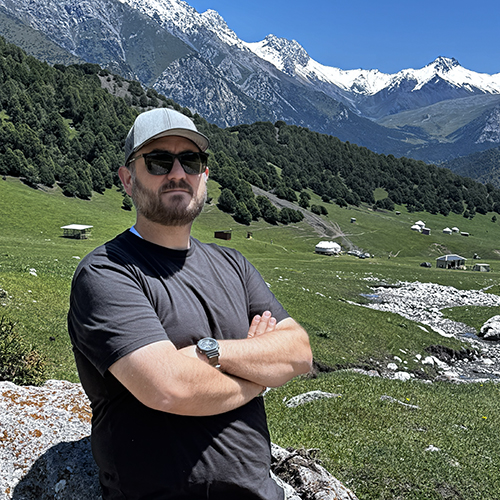When Trisha Brown was a young choreographer in the 1960s, she began collaborating with visual artists, giving their work the same significance as her choreography in her dances. The collaborations continued for decades with renowned artists like Robert Rauschenberg, Donald Judd, Nancy Graves, Fujiko Nakaya, and Terry Winters. This spring the UW is celebrating Brown’s collaborative work through a series of coordinated events that includes an exhibition at the Henry Art Gallery, master classes in the Dance Program, performances by the Trisha Brown Dance Company through the UW World Dance Series (May 20-22), and public lectures.
The Henry Art Gallery exhibition, Trisha Brown: Dance and Art in Dialogue 1961-2001, runs through July 18. It was organized by the Addison Gallery of American Art at Phillips Academy and the Tang Teaching Museum and Art Gallery at Skidmore College. When Henry curator Robin Held learned of the exhibition three years ago, she was immediately interested in bringing it to the Henry.

“The exhibition seemed a perfect fit for the Henry’s mission,” she says. “It provides opportunities to present performances in the museum and to create partnerships on campus and in the community. It brings art audiences and dance audiences together in a way that is very exciting. It also showcases an important interdisciplinary period in art history that tends to be overlooked because of the art’s ephemeral nature that relies on performance documentation.”
Which begs the question, how does a museum showcase collaborations between visual artists and choreographers that occurred decades ago? By displaying existing artworks—sets, drawings, and sculptures—along with historical and contemporary video clips, interviews with the collaborators, and DVDs with performance documentation.
“The challenge is to give the full sense of the work while maintaining its ephemeral character,” says Held, “and to make it come alive for people more used to seeing drawings and paintings on the wall than performance documentation.”

Twice each week (Thursdays, 6-7 pm; Sundays, 2-3 pm), the exhibition literally comes alive, as dancers perform an historic Trisha Brown dance in the Henry Art Gallery, using one of Brown’s more intriguing sets.
“The Henry’s Stroum Gallery is perfect for this,” says Held. “It’s a large and very flexible space, with multiple vantage points. The sets are great even without the dancers, but the performances give visitors a fuller sense of what the choreography and art collaboration might have been. They are the biggest challenge of the exhibition, but they are also the part that makes it so exciting.”
The dance, sponsored by The Boeing Company, is Floor of the Forest, a seminal Trisha Brown work from 1970. The set is a large metal grid with ropes and clothing woven through it. Dancers cross the grid, climbing into and out of the clothing. The dancers are current and former students of the UW Dance Program and Cornish College of the Arts Dance Department.
“This is a great opportunity for our students,” says Betsy Cooper, director of the UW Dance Program. “We talk a lot about historic pieces and watch videos, but we don’t often have the opportunity to dance the choreography of these artists. This is a great wedding of theory and practice.”
Cooper recognizes that Brown’s early work, like Floor of the Forest, may be puzzling for some audiences. Even for some dance students. But that’s okay. “People may question, ‘Is that dance?’” she says. “That’s exactly the question that was being asked in the 1960s. It was a period of questioning everything that dance was—theatrical and narrative-based. For Trisha Brown, that didn’t suit her. A lot of her early work was done in art spaces and galleries. She wanted to get out of the concert hall.”
To ensure the historical accuracy of Floor of the Forest, former Trisha Brown dancer Shelley Senter traveled to Seattle to check the metal grid and rig the clothing used in the dance. Then she trained the dancers performing the piece. “It’s an unusual dance,” says Cooper, “and the dancers needed to get used to being horizontal, negotiating the space and use of weight. But the great thing about this piece is that an advanced dancer can do it and bring that maturity, and a novice dancer can do it too.”

UW dance students will have an opportunity to work with current Trisha Brown Dance Company members as well. Prior to their UW World Series performances, Trisha Brown dancers Sandra Grinberg and Trina Thompson will spend four days on campus teaching technique and repertory classes to intermediate and advanced students in the Dance Program, with support from a College of Arts and Sciences Exchange Award. “It will be a wonderful immersion for our students,” says Cooper. “They can take these classes, visit the Henry exhibition, attend the lectures, and then attend one of the company’s performances.”
For those who want to learn more about Brown’s work, graduate students
in dance will present lectures prior to Trisha Brown Dance Company’s May 20 and 21 performances at Meany Hall, and Brown will present a lecture prior to the May 22 performance.
Betsy Cooper hopes for a big turnout for the Trisha Brown Dance Company’s performances. Personally, she is thrilled to have the company return to Meany Hall.
“At Brown’s last concert here, in 1997, I was aware of how beautifully crafted her compositions were—textured, rich, with unexpected things happening that delighted and surprised me,” says Cooper. “She is continually refining. Audiences should expect to enjoy themselves.”
More Stories

A Sports Obsession Inspires a Career
Thuc Nhi Nguyen got her start the UW Daily. Now she's a sports reporter for Los Angeles Times, writing about the Lakers and the Olympics.

Through Soil Science, an Adventure in Kyrgyzstan
Chemistry PhD alum Jonathan Cox spent most of 2025 in Kyrgyzstan, helping farmers improve their soil—and their crops—through soil testing.

The Public Impact of Private Cities
Geography major Edwin Bai has researched private cities, developed by individuals and corporations, that "take the libertarian idea of low government regulation to the maximum."